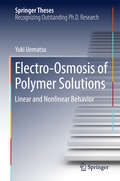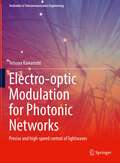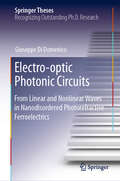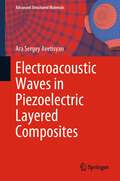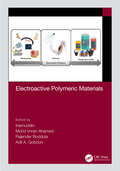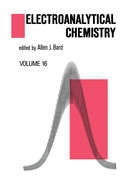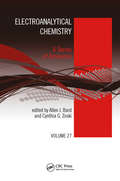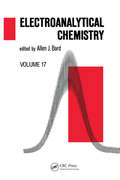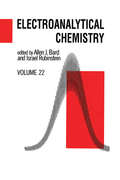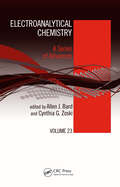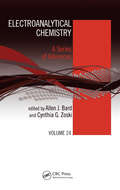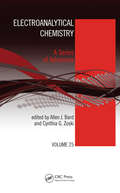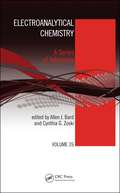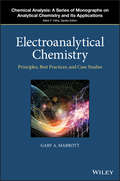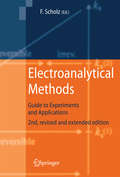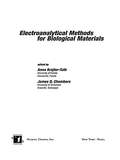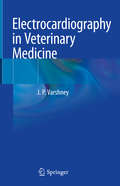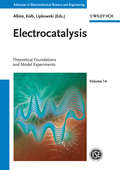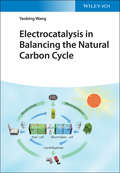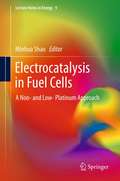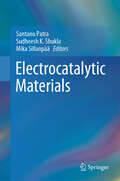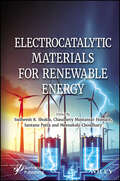- Table View
- List View
Electro-Osmosis of Polymer Solutions
by Yuki UematsuThis thesis focuses on the theoretical description of electro-osmosis of polymer solutions. In particular, it emphasizes the importance of considering non-uniform profiles of the solution viscosity and polymer concentration near a solid surface. The thesis begins with an introduction to fundamental theories and experimental observations for beginners in this field, concerning electrolyte solutions, electric double layers, and electrokinetics. In Chapter 2, the author discusses the linear response of electro-osmotic flow with respect to applied electric fields in aqueous polyelectrolyte solutions, and predicts a possibility of flow reversal caused by oppositely charged polyelectrolytes adsorbed on a charged surface. In Chapter 3, the author extends the discussion to non-linear electro-osmotic flow driven by applied electric fields in neutral polymer solutions. The dynamics of polymers are modeled and simulated using Brownian dynamics and kinetic theory. Finally, the thesis is summarized in Chapter 4. The introduction provides a comprehensive review of electrokinetics for graduate students and researchers interested in soft matter physics. An additional attraction is that readers can effectively learn various theoretical approaches to electro-osmosis.
Electro-optic Modulation for Photonic Networks: Precise and high-speed control of lightwaves (Textbooks in Telecommunication Engineering)
by Tetsuya KawanishiThis textbook provides comprehensive and detailed information on electro-optic modulation, which plays important roles in lightwave networks including optical fiber links, visible ray communications, fiber-wireless, etc. The first part of this book describes roles and basic functions of optical modulators as well as various modulation schemes. The second part is on mathematical expressions dedicated to optical modulation, where sideband generation are clearly described. In conclusion, this book provides useful information for device and system technologies, and helps in understanding fundamental issues on telecommunication systems as well as electro-optic devices. Contents in this book provide valuable information for engineering students in telecommunications. It also gives useful examples of applied mathematics using Bessel functions. It is ideal for upper undergraduate and graduate level classes.Provides comprehensive mathematical expressions dedicated to optical phase modulation based electro-optic effect;Presents practical knowledge of optical modulators as well as basic theory on modulator operation;Includes classroom materials including software and PowerPoint slides for easy integration into curriculum.
Electro-optic Photonic Circuits: From Linear and Nonlinear Waves in Nanodisordered Photorefractive Ferroelectrics (Springer Theses)
by Giuseppe Di DomenicoThis book reports new findings in the fields of nonlinear optics, quantum optics and optical microscopy. It presents the first experimental device able to transform an input Gaussian beam into a non-diffracting Bessel-like beam. The modulation mechanism, i.e. electro-optic effect, allows the device to be fast, miniaturizable and integrable into solid state arrays. Also presented is an extensive study of the superposition of Bessel beams and their propagation in turbid media, with the aim of realizing field that is both localized and non-diffracting. These findings have been implemented in a light-sheet microscope to improve the optical sectioning. From a more theoretical point of view this work also tackles the problem of whether and how a single particle is able to entangle two distant systems. The results obtained introduce fundamental limitations on the use of linear optics for quantum technology. Other chapters are dedicated to a number of experiments carried out on disordered ferroelectrics including negative intrinsic mass dynamics, ferroelectric supercrystals, rogue wave dynamics driven by enhanced disorder and first evidence of spatial optical turbulence.
Electroacoustic Waves in Piezoelectric Layered Composites (Advanced Structured Materials #182)
by Ara Sergey AvetisyanThis book deals concisely and coherently with various issues related to electroacoustic waves in piezoelectric layered composites.Starting with the basic linear equations and relations of electromagnet elasticity of homogeneous anisotropic piezoelectric media, the book considers the conditions for possible field or partial conjugation of physical and mechanical fields at the junction of two homogeneous media with geometrically homogeneous surfaces. The variety of electromechanical boundary conditions and the separation of plane and anti-plane fields of elastic deformation in homogeneous piezoelectric crystals are discussed.Then, the statements of the electroacoustic problem in piezo textures are studied and a layered piecewise-homogeneous piezoelectric waveguide is introduced, with non-acoustic contact between different piezoelectric layers.Non-acoustic contact between different piezoelectric layers can lead to the propagation of a hybrid of electroactive waves of plane and anti-plane elastic deformations.In the last part of the book, the problem of controlling electroacoustic waves in a waveguide is formulated. A method for solving problems of control of electroacoustic waves by non-contact surface action is proposed.
Electroactive Polymeric Materials
by InamuddinElectroactive polymers are smart materials that can undergo size or shape structural deformations in the presence of an electrical field. These lightweight polymeric materials possess properties such as flexibility, cost-effectiveness, rapid response time, easy controllability (especially physical to electrical), and low power consumption. Electroactive Polymeric Materials examines the history, progress, synthesis, and characterization of electroactive polymers and then details their application and potential in fields including biomedical science, environmental remediation, renewable energy, robotics, sensors and textiles. Highlighting the flexibility, lightweight, cost-effective, rapid response time, easy controllability, and low power consumption characteristics of electroactive polymers, respected authors in the field explore their use in sensors, actuators, MEMS, biomedical apparatus, energy storage, packaging, textiles, and corrosion protection to provide readers with a powerhouse of a reference to use for their own endeavors. Features: Explores the most recent advances in all categories of ionic/electroactive polymer composite materials Includes basic science, addresses novel topics, and covers multifunctional applications in one resource Suitable for newcomers, academicians, scientists and R&D industrial experts working in polymer technologies .
Electroanalysis with Carbon Paste Electrodes (Analytical Chemistry)
by Ivan Svancara Kurt Kalcher Alain Walcarius Karel VytrasBecause of their simple preparation and low expense, carbon pastes and carbon paste electrodes are widely used in a myriad of instrumental measurements. With an emphasis on practical applications, Electroanalysis with Carbon Paste Electrodes provides a comprehensive overview of carbon paste electrodes. The text offers a comprehensive and unpreceden
Electroanalytical Chemistry (A Series of Advances #Vol. 16)
by Allen J. BardThis volume provides authoritative reviews in the field of modern electroanalytical chemistry defined in its broadest sense. It is valuable to practicing analytical chemists interested in learning about and applying electroanalytical techniques.
Electroanalytical Chemistry: A Series of Advances, Volume 27 (Electroanalytical Chemistry: A Series of Advances #20)
by Allen J. Bard Cynthia G. ZoskiThis volume is part of a continuing series that provides authoritative reviews on recent developments and applications of well-established techniques in the field of electroanalytical chemistry. Each volume provides the necessary background and starting point for graduate students undertaking related research projects and is of special interest to practicing analytical chemists concerned with electroanalytical techniques. Volume 27 continues this tradition with innovative contributions from internationally respected scientists who highlight new technologies and trends in Protein Biosensing, Bipolar Electrochemistry, and X-ray Absorption Spectroscopy in Electrochemistry.
Electroanalytical Chemistry: A Series of Advances: Volume 15 (Electroanalytical Chemistry: A Series Of Advances Ser.)
by Allen J. BardThis book is designed to provide authoritative reviews in the field of modern electroanalytical chemistry defined in its broadest sense. It is helpful to practicing analytical chemists interested in learning about and applying electroanalytical techniques.
Electroanalytical Chemistry: A Series of Advances: Volume 17
by Allen J. BardThis book examines the metal/solution interface with the electrochemical quartz crystal microbalance, exploring electrostatic adsorption, metal deposition, and roughness. It explores the indirect laser-induced temperature-jump method for characterizing fast interfacial electron transfer.
Electroanalytical Chemistry: A Series of Advances: Volume 22 (Electroanalytical Chemistry: A Series Of Advances Ser. #Vol. 22)
by Allen J. Bard; Israel RubinsteinFor more than three decades the Electroanalytical Chemistry series has delivered the most in-depth and critical research related to issues in electrochemistry. Volume 22 continues this gold-standard with practical reviews of recent applications, as well as innovative contributions from internationally respected specialists highlighti
Electroanalytical Chemistry: A Series of Advances: Volume 23
by Allen J. Bard Cynthia G. ZoskiElectroanalytical chemists and others are concerned not only with the application of new and classical techniques to analytical problems, but also with the fundamental theoretical principles upon which these techniques are based. With the advent of nanotechnology and the drive to create sustainable eco-friendly products, electroanalytical technique
Electroanalytical Chemistry: A Series of Advances: Volume 24 (Electroanalytical Chemistry: A Series of Advances)
by Allen J. Bard Cynthia ZoskiFor more than three decades the Electroanalytical Chemistry Series has delivered the most in-depth and critical research related to issues in electrochemistry. Volume 24 continues this gold-standard with practical reviews of recent applications as well as innovative contributions from internationally respected specialists who highlight the emergenc
Electroanalytical Chemistry: A Series of Advances: Volume 25 (Electroanalytical Chemistry: A Series of Advances)
by Allen J. Bard Cynthia ZoskiThis volume is part of a continuing Electroanalytical Chemistry Series designed to provide authoritative reviews on recent developments and applications of well-established techniques in the field of electroanalytical chemistry. Electroanalytical techniques are used in such diverse areas as electro-organic synthesis, fuel cell studies, and radical
Electroanalytical Chemistry: A Series of Advances: Volume 26
by Allen J. Bard Cynthia G. ZoskiThis book is part of an acclaimed continuing series designed to provide authoritative reviews on recent developments and applications of well-established techniques in the field of electroanalytical chemistry. The 26th volume explores three topics: nanoscale scanning electrochemical microscopy, electrochemical applications of scanning ion conductance microscopy, and electrode surface modification using diazonium salts. Each volume provides the necessary background and a starting point for graduate students undertaking related research projects as well as practicing analytical chemists concerned with electroanalytical techniques and their fundamental principles.
Electroanalytical Chemistry: Principles, Best Practices, and Case Studies (Chemical Analysis: A Series of Monographs on Analytical Chemistry and Its Applications)
by Gary A. MabbottProvides a strong foundation in electrochemical principles and best practices Written for undergraduate majors in chemistry and chemical engineering, this book teaches the basic principles of electroanalytical chemistry and illustrates best practices through the use of case studies of organic reactions and catalysis using voltammetric methods and of the measurement of clinical and environmental analytes by potentiometric techniques. It provides insight beyond the field of analysis as students address problems arising in many areas of science and technology. The book also emphasizes electrochemical phenomena and conceptual models to help readers understand the influence of experimental conditions and the interpretation of results for common potentiometric and voltammetric methods. Electroanalytical Chemistry: Principles, Best Practices, and Case Studies begins by introducing some basic concepts in electrical phenomena. It then moves on to a chapter that examines the potentiometry of oxidation-reduction processes, followed by another on the potentiometry of ion selective electrodes. Other sections look at: applications of ion selective electrodes; controlled potential methods; case studies in controlled potential methods; and instrumentation. The book also features several appendixes covering: Ionic Strength, Activity and Activity Coefficients; The Nicolsky-Eisenman Equation; The Henderson Equation for Liquid Junction Potentials; Selected Standard Electrode Potentials; and The Nernst Equation Derivation. Introduces the principles of modern electrochemical sensors and instrumental chemical analysis using potentiometric and voltammetric methods Develops conceptual models underlying electrochemical phenomena and useful equations Illustrates best practice with short case studies of organic reaction mechanisms using voltammetry and quantitative analysis with ion selective electrodes Offers instructors the opportunity to select focus areas and tailor the book to their course by providing a collection of shorter texts, each dedicated to a single field Intended as one of a series of modules for teaching undergraduate courses in instrumental chemical analysis Electroanalytical Chemistry: Principles, Best Practices, and Case Studies is an ideal textbook for undergraduate majors in chemistry and chemical engineering taking instrumental analysis courses. It would also benefit professional chemists who need an introduction to potentiometry or voltammetry.
Electroanalytical Methods
by Fritz ScholzResearchers and professionals will find a hands-on guide to successful experiments and applications of modern electroanalytical techniques here. The new edition has been completely revised and extended by a chapter on quartz-crystal microbalances. The book is written for chemists, biochemists, environmental and materials scientists, and physicists. A basic knowledge of chemistry and physics is sufficient for understanding the described methods. Electroanalytical techniques are particularly useful for qualitative and quantitative analysis of chemical, biochemical, and physical systems. Experienced experts provide the necessary theoretical background of electrochemistry and thoroughly describe frequently used measuring techniques. Special attention is given to experimental details and data evaluation.
Electroanalytical Methods Of Biological Materials
by Anna Brajter-TothThis text details contemporary electroanalytical strategies of biomolecules and electrical phenomena in biological systems. It presents significant developments in sequence-specific DNA detection for more efficient and cost-effective medical diagnosis of genetic and infectious diseases and microbial and viral pathogens. The authors discuss the latest advances in amperometric biosensing, capillary electrophoresis, DNA amplification and detection, single-cell neurochemistry, in vivo electrochemistry, and electrochemical immunoassay. They also present recent techniques to evaluate the reaction properties of complex electron-transport enzymes and describe the use of fast-scan cyclic voltammetry (FSCV) to study the mechanisms and kinetics of dopamine neurotransmission, among other topics.
Electrocardiography in Veterinary Medicine
by J.P. VarshneyThis book provides essential information on methodologies for recording electrocardiograms in various animal species, including dogs, cats, cattle, buffaloes, sheep, goats, mithun, chelonians, snakes, avians, equines, rabbits, and the Indian gray mongoose. It also reviews the electrocardiographic physiology, generation of electrocardiograms, and normal criteria for various animal species; electrocardiograms in health and disease; and the interpretation of abnormal electrocardiograms, cardiomyopathy and arrhythmias, with corresponding treatment protocols.Further, it presents several approaches to interpreting the electrocardiograms of dogs, cats, ruminants, tortoises, pigeons, and other animals, offering a valuable resource for all veterinary students, scientists, and physicians wanting to make greater use of this valuable non-invasive tool in the diagnosis of heart diseases and general health examinations.
Electrocatalysis
by Richard C. Alkire Dieter M. Kolb Jacek LipkowskiCatalysts speed up a chemical reaction or allow for reactions to take place that would not otherwise occur. The chemical nature of a catalyst and its structure are crucial for interactions with reaction intermediates. An electrocatalyst is used in an electrochemical reaction, for example in a fuel cell to produce electricity. In this case, reaction rates are also dependent on the electrode potential and the structure of the electrical double-layer. This work provides a valuable overview of this rapidly developing field by focusing on the aspects that drive the research of today and tomorrow. Key topics are discussed by leading experts, making this book a must-have for many scientists of the fi eld with backgrounds in different disciplines, including chemistry, physics, biochemistry, engineering as well as surface and materials science. This book is volume XIV in the series "Advances in Electrochemical Sciences and Engineering".
Electrocatalysis in Balancing the Natural Carbon Cycle
by Yaobing WangExplore the potential of electrocatalysis to balance an off-kilter natural carbon cycle In Electrocatalysis in Balancing the Natural Carbon Cycle, accomplished researcher and author, Yaobing Wang, delivers a focused examination of why and how to solve the unbalance of the natural carbon cycle with electrocatalysis. The book introduces the natural carbon cycle and analyzes current bottlenecks being caused by human activities. It then examines fundamental topics, including CO2 reduction, water splitting, and small molecule (alcohols and acid) oxidation to prove the feasibility and advantages of using electrocatalysis to tune the unbalanced carbon cycle. You’ll realize modern aspects of electrocatalysis through the operando diagnostic and predictable mechanistic investigations. Further, you will be able to evaluate and manage the efficiency of the electrocatalytic reactions. The distinguished author presents a holistic view of solving an unbalanced natural carbon cycle with electrocatalysis. Readers will also benefit from the inclusion of: A thorough introduction to the natural carbon cycle and the anthropogenic carbon cycle, including inorganic carbon to organic carbon and vice versa An exploration of electrochemical catalysis processes, including water splitting and the electrochemistry CO2 reduction reaction (ECO2RR) A practical discussion of water and fuel basic redox parameters, including electrocatalytic materials and their performance evaluation in different electrocatalytic cells A perspective of the operando approaches and computational fundamentals and advances of different electrocatalytic redox reactions Perfect for electrochemists, catalytic chemists, environmental and physical chemists, and inorganic chemists, Electrocatalysis in Balancing the Natural Carbon Cycle will also earn a place in the libraries of solid state and theoretical chemists seeking a one-stop reference for all aspects of electrocatalysis in carbon cycle-related reactions.
Electrocatalysis in Fuel Cells
by Minhua ShaoFuel cells are one of the most promising clean energy conversion devices that can solve the environmental and energy problems in our society. However, the high platinum loading of fuel cells - and thus their high cost - prevents their commercialization. Non- or low- platinum electrocatalysts are needed to lower the fuel cell cost. Electrocatalysis in Fuel Cells: A Non and Low Platinum Approach is a comprehensive book summarizing recent advances of electrocatalysis in oxygen reduction and alcohol oxidation, with a particular focus on non- and low-Pt electrocatalysts. All twenty four chapters were written by worldwide experts in their fields. The fundamentals and applications of novel electrocatalysts are discussed thoroughly in the book. The book is geared toward researchers in the field, postgraduate students and lecturers, and scientists and engineers at fuel cell and automotive companies. It can even be a reference book for those who are interested in this area.
Electrocatalysis: Computational, Experimental, and Industrial Aspects
by Carlos Fernando ZinolaElectrocatalysis applications are employed in a large number of industries worldwide, ranging from old technologies such as galvanoplasty to the most up-to-date deployments involving ultracapacitators. Recognizing electrocatalysis as a useful interfacial approach to a dynamic interdisciplinary science, Electrocatalysis: Computational, Experimental,
Electrocatalytic Materials
by Mika Sillanpää Sudheesh K. Shukla Santanu PatraThis handbook focuses on electrocatalytic materials, a field that has experienced significant advancements in recent decades, primarily driven by nanoscale catalyst design improvements. These advancements have been crucial in the development and enhancement of alternative energy technologies relying on electrochemical reactions. Electrocatalytic materials play a vital role in reducing over-potentials required for electrochemical device operation. As a prominent subset of catalysts, they facilitate essential reactions for energy conversion and storage through electron transfer processes. However, studying electrocatalytic materials presents challenges due to complex reaction networks, diverse selectivity possibilities, and intricate reaction mechanisms. This book offers an extensive description of electrocatalysis and the materials used in electrocatalytic processes. It covers cutting-edge studies and in-depth discussions on the applications of electrocatalytic materials in energy conversion and storage (including fuel cells, water splitting, batteries, etc.), sensors, and other potential applications. It also addresses the broader implications of electrocatalysis in academia and industry. Each section of the book highlights the latest developments, contemporary challenges, and state-of-the-art investigations aimed at producing valuable outcomes for end users. With contributions from diverse experts, this comprehensive resource is essential for researchers, scientists, industrialists, educators, and students.
Electrocatalytic Materials for Renewable Energy
by Chaudhery Mustansar Hussain Sudheesh K. Shukla Santanu Patra Meenakshi ChoudharyELECTROCATALYTIC MATERIALS FOR RENEWABLE ENERGY The book provides a comprehensive overview of various electrocatalytic materials and their applications in renewable energy thereby promoting a sustainable and clean energy future for all. As an important branch of catalysts, electrocatalytic materials exhibit important catalytic reactions that can convert and store energy through reactions involving electron transfer. However, the study of electrocatalytic materials presents a huge challenge due to the highly complicated reaction network, the variety of reaction selectivity, and the puzzling reaction mechanisms. Tremendous research efforts have been made toward the fabrication of efficient electrocatalytic materials that can be used in the energy sectors. The book covers a wide range of topics, including the synthesis, characterization, and performance evaluation of electrocatalytic materials for different renewable energy applications. Furthermore, the book discusses the challenges and opportunities associated with the development and utilization of electrocatalytic materials for renewable energy. The future utility of different electrocatalytic materials is also well-defined in the context of the renewable energy approach. The contributors to this book are leading experts in the field of electrocatalytic materials for renewable energy, including scientists and engineers from academia, industry, and national laboratories. Their collective expertise and knowledge provide valuable insights into the latest advances in electrocatalysis for renewable energy applications. Audience This book is intended for researchers and professionals in the fields of materials science, chemistry, physics, and engineering who are interested in the development and utilization of electrocatalytic materials for renewable energy.
